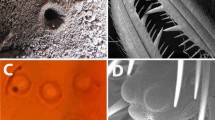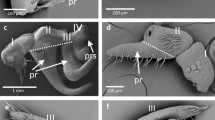Abstract
The type II microtrich sensilla on the lotic amphipod Gammarus pseudolimnaeus Bousfield enable it to control body orientation while swimming, as animals with their sensilla masked spent significantly more time swimming on their sides. These sensilla appear to be involved in the behavioural process that allows the animal to orient into the current (positive rheotaxis), as significantly fewer masked animals were able to turn into novel current flows compared with controls. The sensilla do not appear to play a role in detecting gravity. Results suggest that the sensilla transmit hydromechanical sensory information to the animal, and it is thought that the individual sensilla act in unison as a kinetic sensory organ. The sensilla are well adapted for such a hydromechanical role, as they would likely only be stimulated by currents hitting them broadside on. The sensilla are grouped, with each sensillum facing in a different direction, and the groups are located at appropriate positions for detecting current flows. The sensilla do not play a role in the detection of vibrations. Nor do they play a chemosensory role in the detection of food or predators; however, a role in conspecific chemodetection cannot be ruled out.
Similar content being viewed by others
References
Abacus Concepts, Inc., 1986. Interactive Statistics and Graphics Package, Version 1.1.
Ache, B. W., 1982. Chemoreception and Thermoreception. In D. N. Bliss, H. L. Atwood & D. C. Sandeman (eds), Biology of Crustacea. Academic Press, New York: 3. 369–398.
Adler, H. E., 1970. Ontogeny and Phylogeny of orientation. In L. R. Aronson, E. Tobach, D. S. Lehrman & J. S. Rosenblatt (eds), Essays in memory of T. C. Schneirla. W. H. Freeman, San Francisco: 303–336.
Adler, H. E., 1971. Orientation in animals and man. In Orientation, Sensory Basis. Ann. N.Y. Acad. Sci. 188: 3–4.
Altner, H., 1977. Insect sensillum specificity and structure: an approach to a new typology. In J. LeMagnen & P. MacLeod (eds), Proceedings of the Sixth International Symposium on Olfaction and Taste. Informatio Retrieval, Ltd., London: 295–303.
Altner, H. & L. Prillinger, 1980. Ultrastructure of invertebrate chemo-, thermo-, and thigmoreceptors and its functional significance. Int. Revue Cytol. 67: 69–139.
Barnes, R. D., 1987. Invertebrate Zoology, 5th edn. Saunders College Publishing, Philadelphia.
Barth, R. G., 1981. Strain detection in the arthropod exoskeleton. In M. S. Laverack & D. J. Cosens (eds), Sense Organs. Blackie, Glasgow, London: 112–141.
Bauer, R. T., 1979. Sex attraction and recognition in the Caridean shrimp Heptacarpus paludicola Holmes (Decapoda: Hippolytidae). Mar. Behav. Physiol. 6: 157–174.
Bullock, T. H. & G. A. Horridge, 1965. Structure and function in the nervous system of invertebrates. Volumes 1 and 2. Freeman and Col, San Francisco.
Bush, B. M. H. & M. S. Laverack, 1982. Mechanoreception In D. N. Bliss, H. L. Atwood & & D. C. Sandeman (eds), Biology of Crustacea. Academic Press, New York 3. 369–398.
Caldwell, R. L., 1979. Cavity occupation and defensive behaviour in the Stomatopod Gonodactylus Festai: evidence for chemically mediated individual recognition. Anim. Behav. 27: 194–201.
Crouau, Y., 1982. Primary stages in the sensory mechanism of the setulate sensilla, external mechanoreceptors of a Cavernicolous Mysidacea. Biol. Cell 44: 45–56.
Cuadras, J., 1982. Microtrichs of amphipod crustacea. Morphology and distribution. Mar. Behav. Physiol. 8: 333–343.
Dahl, E., H. Emaneulsson & C. von Mecklenburg, 1970. Pheromone reception in the males of the amphipod Gammarus duebeni Lilljeborg. Oikos 21: 42–47.
Denton, E. J. & J. Gray, 1985. Lateral-line-like antennae of certain of the Penaeidae (Crust., Decap., Natantia). Proc. R. Soc. Lond. B 226: 249–261.
Derby, C. D., 1982. Structure and function of cuticular sensilla of the lobster Homarus americanus. J. Crustacean Biol. 2: 1–21.
Dethier, V. G., 1963. The physiology of insect senses. Methuen, London.
Dijkgraaf, S., 1967. Biological significance of the lateral line organs. In P. Cahn (ed.), Lateral line organs. Indiana University Press, Bloomington: 83–95.
Dill, L. M., 1987. Animal decision making and its ecological consequences: the future of aquatic ecology and behaviour. Can. J. Zool. 65: 803–811.
Eckert, R. & D. Randall, 1983. Animal Physiology: Mechanisms and adaptations. W. H. Freeman and Company, New York.
Evoy, W. H. & J. Ayers, 1982. Locomotion and Control of Limb movements. In D. N. Bliss, D. C. Sandman & H. C. Atwood (eds), Biology of Crustacea. Academic Press, New York 4. 62–106.
Feltmate, B. W., R. L. Baker & P. J. Pointing, 1986. Distribution of the stonefly nymph Paragnetina media (Plecoptera: Perlidae): Influence of prey, predators, current speed, and substrate composition. Can. J. Fish. aquat. Sci. 43: 1582–1587.
Feltmate, B. W. & D. D. Williams, 1989. A test of crypsis and predator avoidance in the stonefly Paragnetina media (Plecoptera: Perlidae). Anim. Behav. 37: 992–999.
Ferrero, E. A., M. S. Laverack, M. Morin & M. Spoto, 1984. Morpho-physiological and behavioural bases of the chemoreception evidentiated on Squilla mantis (Crustacea, Stomatopoda) Abdominal Tergites. Nova Thalassia 6: 749–750.
Gleeson, R. A., 1980. Pheromone communication in the reproductive behaviour of the blue crab, Callinectes sapidus. Mar. Behav. Physiol. 7: 119–134.
Halcrow, K. & E. L. Bousfield, 1987. Scanning electron microscopy of surface microstructures of some gammaridean amphipod crustaceans. J. Crustacean Biol. 7: 274–287.
Hargreaves, B. R., 1981. Energetics of crustacean swimming. In C. F. Herreid & C. R. Fourtner (eds), Locomotion and energetics in arthropods. Plenum Press, New York: 453–490.
Hawkins, A. D. & K. Horner, 1981. The acoustic lateralis system of aquatic vertebrates. In M. S. Laverack & D. J. Cosens (eds), Sense Organs. Blackie, Glasgow, London: 220–254.
Kapoor, N. N., 1985. External morphology and distribution of the antennal sensilla of the stonefly, Paragnetina media (Walker) (Plecoptera: Perlidae). Int. J. Insect Morphol. Embryol. 14: 273–280.
Kapoor, N. N. & K. Zachariah, 1983. Ultrastructure of the sensilla of the stonefly nymph, Thaumatoperla alpina Burns and Neboiss (Plecoptera: Eustheniidae). Int. J. Insect Morphol. Embryol. 12: 157–168.
Krebs, C. J., 1985. Ecology: The experimental analysis of distribution and abundance, 3rd ed. Harper and Row Publishers, New York.
Laverack, M. S., 1976. External Proprioceptors. In P. J. Mill (ed.), Structure and Function of proprioceptors in the invertebrates. Chapman and Hall, London: 1–63.
Laverack, M. S., 1981. The adaptive radiation of sense organs. In M. S. Laverack & D. J. Cosens (eds), Sense Organs. Blackie, Glasgow London: 7–30.
Laverack, M. S. & Y. Barrientos, 1985. Sensory and other superficial structures in living marine crustacea. Trans. r. Soc. Edinb. 76: 123–136.
Marchant, R. & H. B. N. Hynes, 1981. Field estimates of feeding rate for Gammarus pseudolimnaeus (Crustacea: Amphipoda) in the Credit River, Ontario. Freshwat. Biol. 11: 27–36.
Mauchline, J., Y. Aizawa, T. Ishimaru, S. Nishida & R. Marumo, 1977. Integumental sensilla of pelagic decapod crustaceans. Mar. Biol. (Berlin) 43: 145–156.
McIver, S. B., 1975. Structure of cuticular mechanoreceptors of Arthropods. Ann. Rev. Ent. 20: 381–397.
Mellon, DeF., 1963. Electrical responses from dually innervated tactile receptors on the thorax of the crayfish. J. exp. Biol. 40: 137–148.
Miller, J., 1975. Structure and function of trilobite terrace lines. Fossils and Strata 4: 155–178.
Oakley, J. K. & D. L. Macmillan, 1980. The morphology and physiology of CAP organs in Jasus novaehollandiae (Crustacea, Decapoda, Reptantia, Macrura). Mar. Behav. Physiol. 7: 233–247.
Offutt, C. G., 1970. Acoustic stimulus perception by the American lobster Homarus. Experientia 26: 1276–1278.
Oshel, P. E., V. J. Steele & D. H. Steele, 1988. Comparative SEM Morphology of Amphipod Microtrich Sensilla. Crustaceana, Suppl. 13: 100–106.
Platvoet, D., 1985. Side-line organ in gammarids (Crustacea, Amphipoda). Beaufortia 35: 129–133.
Read, A. T. & D. D. Williams, 1991. The distribution, external morphology, and presumptive function of the surface microstructures of Gammarus pseudolimnaeus (Crustacea: Amphipoda), with emphasis on the calceolus. Can. J. Zool. 69: 853–865.
Sakhuja, M., D. D. Williams & N. E. Williams, 1983. The role of setae in the behaviour of larval Phryganea cinerea Walker (Trichoptera: Phryganeidae). Can. J. Zool. 61: 725–731.
Sandeman, D. C., 1976. Spatial equilibrium in the arthropods. In P. J. Mill (ed.), Structure and function of proprioceptors in the invertebrates. Chapman and Hall, London: 485–527.
Scheirer, C. J., W. S. Ray & H. Hare, 1976. The analysis of ranked data derived from completely randomized factorial designs. Biometrics 32: 429–434.
Schneirla, T. C., 1929. Learning and orientation in ants. Comp. Psychol. Monogr. 6 No. 4.
Schwartzkoff, J., 1964. Mechanoreceptors. In: M. Rockstein (ed.), The physiology of Insecta, Vol 1. Academic Press, New York: 509–561.
Schwedhelm, E., 1984. Ein neues sinnesorgan bei Gammarus (A new sense organ on Gammarus). Naturwissenschaften 71: 51.
Shelton, R. G. J. & M. S. Laverack, 1970. Receptor hair structure and function in the lobster Homarus gammarus (L.). J. Exp. Mar. Biol. Ecol. 4: 201–210.
Sokal, R. R. & F. J. Rohlf, 1981. Biometry: The principles and practice of statistics in Biological research, 2nd edn. W. H. Freeman and Company, San Francisco.
Statzner, B., 1987. Characteristics of lotic ecosystems and consequences for future research directions. In E-D. Schultze & H. Zwölfer (eds), Ecological Studies, vol 61. Springer-Verlag, Berlin Heideberg: 365–390.
Steele, V. J. & P. E. Oshel, 1987. The ultrastructure of an integumental microtrich sensillum in Gammarus setosus (Amphipoda). J. Crustacean Biol. 7: 45–59.
SYSTAT, Inc., 1988. SYSTAT, Version 3.2.
Tautz, J., 1979. Reception of particle oscillation in a medium — an unorthodox sensory capacity. Naturwissenschaften 66: 452–461.
Tautz, J., 1987. Water vibration elicits active antennal movements in the crayfish, Orconectes limosus. Anim. Behav. 35: 748–754.
Tautz, J., W. M. Masters, B. Aicher & H. Markl, 1981. A new type of water vibration receptor on the crayfish antenna l. Sensory physiology. J. Comp. Physiol. 144: 533–541.
Vedel, J. P. & F. Clarac, 1976. Hydrodynamic sensitivity by cuticular organs in the rock lobster Palinurus vulgaris. Morphological and physiological aspects. Mar. Behav. Physiol. 3: 235–251.
Warner, G. F., 1977. The Biology of Crabs. Van Nostrand Reinhold Company, New York.
Waters, T. F., 1984. Annual production by Gammarus pseudolimnaeus among substrate types in Valley creek, Minnesota. Am. Midl. Nat. 112: 95–102.
Wiese, K., 1976. Mechanoreceptors for near-field water displacements in crayfish. J. Neurophysiol. 39: 816–833.
Williams, D. D. & G. P. Levens, 1988. Evidence that hunger and limb loss can contribute to stream invertebrate drift. J. N. Am. Benth. Soc. 7: 180–187.
Williams, D. D. & K. A. Moore, 1982. The effect of environmental factors on the activity of Gammarus pseudolimnaeus (Amphipoda). Hydrobiologia 96: 137–147.
Williams, D. D. & K. A. Moore, 1985. The role of semiochemicals in benthic community relationships of the lotic amphipod Gammarus pseudolimnaeus: a laboratory analysis. Oikos 44: 280–286.
Williams, D. D. & K. A. Moore, 1986. Microhabitat selection by a stream-dwelling amphipod: a multivariate analysis approach. Freshwat. Biol. 16: 115–122.
Williams, D. D. & K. A. Moore, 1989. Environmental complexity and the drifting behaviour of a running water amphipod. Can. J. Fish. aquat. Sci. 46: 1520–1530.
Young, J. Z., 1981. The life of vertebrates, 3rd edn. Clarendon Press, Oxford.
Author information
Authors and Affiliations
Rights and permissions
About this article
Cite this article
Olyslager, N.J., Williams, D.D. Function of the type 11 microtrich sensilla on the lotic amphipod, Gammarus pseudolimnaeus Bousfield. Hydrobiologia 259, 17–31 (1993). https://doi.org/10.1007/BF00005961
Received:
Revised:
Accepted:
Issue Date:
DOI: https://doi.org/10.1007/BF00005961




